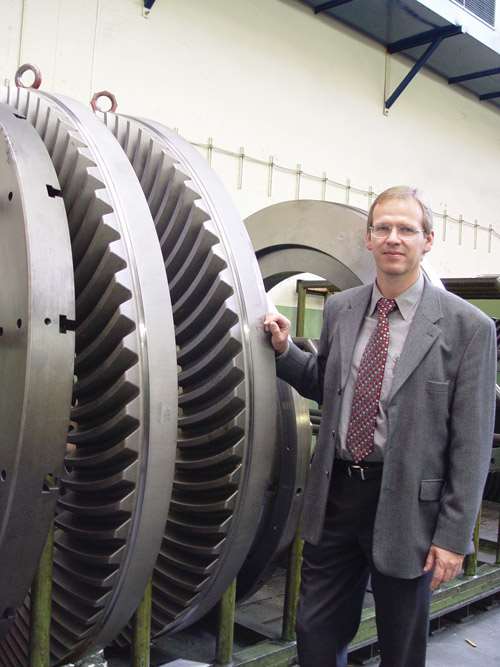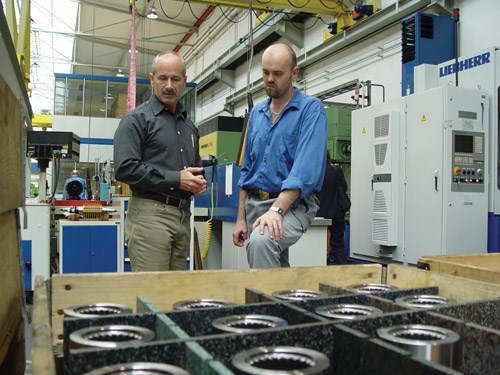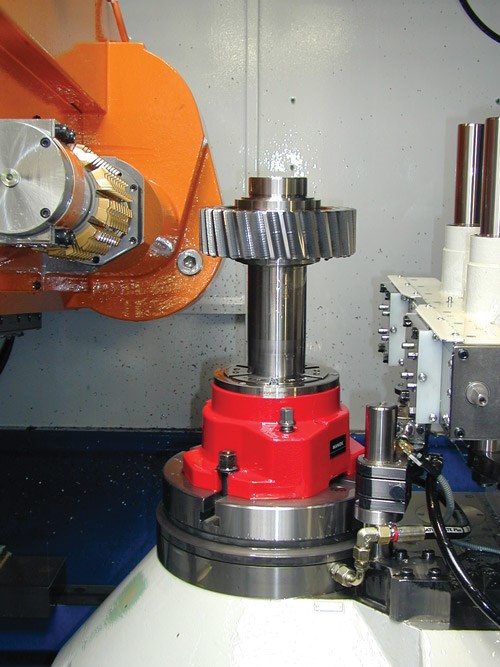Published
Clamping Devices Ensure Power Boost for Turbo Manufacturer
In order to efficiently manufacture more than 12,000 toothed parts with a range of dimensions having lot sizes of 1 to 50, a shop needs to focus not only on the cutting parameters, but also developing a strategy for handling the tremendous setup time.
Senior Editor,
Products Finishing
In order to efficiently manufacture more than 12,000 toothed parts with a range of dimensions having lot sizes of 1 to 50, a shop needs to focus not only on the cutting parameters, but also developing a strategy for handling the tremendous setup time. The manufacturing engineers at Voith Turbo succeeded in this balancing act by selecting clamping devices for both individual part production and small-series production runs. In addition, the gear cutting knowledge that was gained offers valuable insight for other machining processes.
“If we do not constantly improve ourselves, we lose,” says Dieter Ruppe, workshop master at Voith Turbo in Heidenheim, which is located in the German state of Baden-Württemberg. His sentiment is also visible on the factory floor.
The Drive Technology Division of the Voith Group employs 3,500 employees to ensure low friction losses and maximum drive. During the last 140 years, Voith Turbo has developed the production of hydrodynamic gear units for high performance rail vehicles and commercial vehicles. Customer requests, such as low price, and reliability, as well as availability of spare parts over a period of more than 20 years, must all be considered.
The company attempts to meet the requirement for short throughput times through advances in technology and lean manufacturing principles. In total, there are 12,000 different types of toothed parts, ranging in diameter from about 50 mm to 2,000 mm.
Johannes Wolfensberger, workshop director, cites the difficulties in this regard. “We move between pure single-part manufacturing and series production, and consequently, we can only use current automation methods to a limited extent. In addition, we must guarantee availability of spare parts over a period of more than 20 years.”
Low Volume, High Mix Challenges
The variety of lot sizes and part sizes, as well as numerous tooth shapes and types, require a significant effort relative to part-specific fixture construction. “The fact that we can manufacture all of the parts ourselves is a benefit to us,” Mr. Wolfensberger says. “However, it is also our handicap. We must expend enormous effort on the fixture construction side. Part-specific fixtures must be designed, manufactured and stored.”
In addition to an increase in productivity, the specification also cites a reduction in the scope of fixtures, along with faster availability. For simple spur gears, this can be 8 to 12 weeks; for complex special variants, it can be as long as 8 months.
To improve order flow, the gear variants are organized into part families. The manufacturing orders are given to the machines as a package, while the fine scheduling of these work orders resides in the machine operator’s responsibility. Additionally, the number of work steps is consolidated on the appropriate machines with multitasking capability. Integration of subordinate process steps, such as parts cleaning, deburring or marking, is an essential means of shortening throughput times. Valuable time is lost in transport, storage, and signing on and off of these work sequences.
“Handling these steps in a distributed manner at the machine significantly reduces our throughput times,” Mr. Wolfensberger explains. The organizational restructuring appears to be particularly worthwhile, because, according to Mr. Wolfensberger, the machining time comprises only 5 to 15 percent of the actual throughput time. The rest of the time is comprised of stand-still and non-productive machine times before the actual machining steps.
Making an Investment
The costs were adding up, not only for design, manufacturing and storage of the fixtures, but also the maintenance and transport costs. Thus, creation and optimization of the fixtures would negatively impact the throughput times of the gears. As Mr. Wolfensberger describes the problem, the customers no longer accepted the fact that they had to wait longer for the gear than the time it would take to manufacture the overall system.
Ultimately, an investment in a gear hobbing machine was the spark for an essential reduction of setup times and other machine idle times. Both the capacity of the machine, as well as the cutting data recommended by the tool manufacturers promised a significant increase in productivity.
However, to realize these productivity gains, a new clamping approach had to be found. The sought-for solution had to satisfy the following requirements: universal use for a variety of parts, accuracy, process reliability, automation capability, user friendliness, safety, short delivery times and good price/performance ratio. The machine tool manufacturer was able to contribute helpful tips for the selection of the clamping device.
Motivated by recommendations from the machine supplier, Voith engineers attended the Hainbuch Technology Forum in Marbach, Germany. While reviewing the array of workholding technology that was available, the Hainbuch MANOK stationary chuck caught the engineers’ attention. The clamping device reduces setup times and non-productive machine times and unlocks reserves in the machining process.
The stationary chuck not only satisfied the customer’s requirements, but the clamping device could also provide each individual clamping head with a high clamping force of 70 kN and a clamping range of ± 0.3 mm. This means that exact fits for each workpiece are no longer required; only roundness and concentricity are required on the clamping shoulder of the workpiece. The clamping device was able to satisfy the technical requirements, and it was also able to increase the machining parameters.
Mr. Wolfensberger recalls, “Earlier, we could often not achieve the recommendations of the tool manufacturers. Frequently, this was because of a clamping device that was too unstable. The vibrations in the machining process significantly lowered the service life of the tools. The recommendations can only be realized via an optimized total system consisting of a machine, cutting tool and clamping device. In this specific case, the machining time was reduced by 42 percent.”
Unlocking Reserves in the Machining Process
In addition to improvements in the milling process, the stationary chuck is also impressive in part handling. “Setup times can be reduced by as much as 80 percent, plus there are numerous positive side effects,” Mr. Wolfensberger says.
Workshop master, Mr. Ruppe, says, “The clamping device functions simply, reliably and quickly, and this has had a very positive effect, particularly in three-shift or night-shift operation. Uncomplicated handling reduced susceptibility to faults and increased process reliability.” He adds, “The tasks for the craftsman at the machine are constantly increasing—the craftsman has a lot of responsibility. Simple and practical solutions that quickly reach the goal are in demand.”
Reducing Expenses
Significant savings also occur in the construction, manufacturing and storage of the clamping devices. Mr. Wolfensberger thinks it would be possible to cut this cost in half if the new clamping is consistently implemented.
Mr. Wolfensberger, Mr. Ruppe, and their colleagues will not rest on these isolated successes. “We are thinking of transferring this workholding to other machining steps, such as turning or grinding.” Mr. Wolfensberger considers that the balance between flexibility and standardization is successful, which is positively demonstrated through the 20-percent reduction in throughput times for gear cutting.
“We are only getting started; the overall potential is much greater,” Mr. Wolfensberger says, who stresses the central role of the clamping device. “Whoever invests in a machine and stays with the old clamping methods does not get any tangible improvements, but rather, squanders the potential that would have been possible through the active investment in machine, cutting tool and workholding technologies.”
The investment Voith Turbo made in the Hainbuch clamping device ensures the company efficiency, cost reduction and process reliability for years to come.







